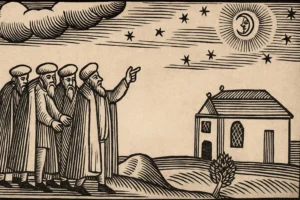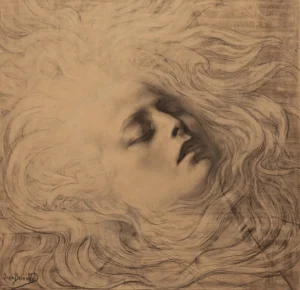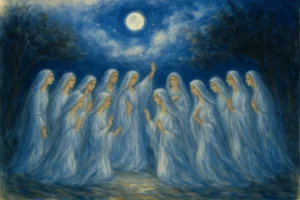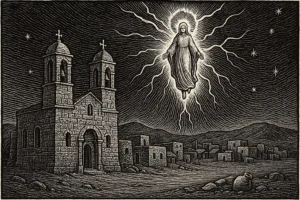To explore Gamaliel is to descend into the cellar of the Tree of Life, where the lunar shimmer of Yesod yields to the silver’s reverse: the night of shells, the dwelling of the Shadow. Gamaliel is not merely the “opposite” of Yesod; she is its distortion, the echo that resounds where desire fails to become pure image but turns into obscure mirage, a reflection of a reflection.
In classical Kabbalah, Yesod is the Ninth Sephira, “Foundation”, the lunar mirror which transmits, filters, and transforms the energy of the higher spheres to Malkuth. It is the principle of Dream, Imagination, Creative Eros, associated with the Moon, fertile unconscious, and the power to connect and transmit. Yesod is translucent, receptive, but like every mirror, it has a reverse.
Gamaliel emerges in the system of the Qliphoth, the “shells”, “husks” or “peels”, a concept germinal in the Zohar but codified by Jewish mystics of the sixteenth century and then systematised in modern occultism, particularly in the nineteenth and twentieth centuries (Eliphas Levi, Mathers, Crowley, and the Golden Dawn). The Qliphoth represent negativity, corruption, the distortion of Divine principles; they are exiled energies, expulsed forces, all that cannot be integrated without risk of dissolution.
The name “Gamaliel” is of Hebrew origin and, at first glance, means “God is my recompense” or “God is my reward” (from גמל – gamal, ‘to give’, ‘to recompense’). It is also the name of rabbinic sages (the Gamaliels of the Talmud), but here the word is displaced, perverted, reinscribed on the nocturnal side of symbolism. In the Qliphothic context, Gamaliel is known as “The Obscene One”, “The Polluter”, “She Who Defiles”. She corresponds to the inverted Qliphah of Yesod, the “Order of the Foundation”. If Yesod is the Gate of Sacred Dreams and Imagination, Gamaliel is the “Order of Obscene Images”, domain of distorted dreams, voluptuous illusion, desacralised eroticism.
In the Qliphothic schema, as proposed in sources like The Kabbalah Unveiled and further developed by Mathers, Crowley, Kenneth Grant, and others, Gamaliel is the ninth Qliphah, situated below Samael (the distortion of Hod), and above Lilith/Nahemoth (the “Earth of the Dead”, opposite Malkuth). Gamaliel represents the dark side of lunar power: pornography, illusion, unconfessable desires, sexuality unbound from the sacred, obsession with the surface and image, fascination with the mutable, the spectral, the phantasmal.
Operatively and symbolically, to explore Gamaliel is to give voice to unmasked desire; it is to plunge into dark dreams, to give form to what is never confessed in the light. It is not a matter of demonising the Shadow, but of recognising Her as part of the lunar cycle: all light casts shadow, every mirror has a reverse. Gamaliel is the voice of the New Moon, the Lady of the Veil, the matrix where dreams become delirium. The danger does not lie in recognising Her, but in refusing Her name, for it is always what is denied that possesses us.
Historically, the idea of the Qliphoth arises as a mystical response to the problem of evil: if the Divine is pure light, where does darkness originate? Medieval Kabbalists responded that the Qliphoth are remnants, “shells” of the sephirot, debris of creation; fallen energies, residue of excess or what cannot be integrated. The desire that Yesod ought to purify becomes, in Gamaliel, compulsion, vice, toxic pleasure, eros that consumes without fertilising. Modern occult tradition amplified the concept: Crowley and Kenneth Grant associate Gamaliel with lurid dreams, erotic phantasms, and the manifestations of sexual shadow in ritual.
Ritual Examples: Tradition to the Present
Rituals for confronting Gamaliel arise whenever the inner night demands naming, when the practitioner seeks to confront that which has been repressed, sexualised, or turned to shadow. In the Golden Dawn tradition, there were practices of lunar visualisation in darkened rooms, silver mirrors veiled in black cloth, invocations to the “Dark Lady” and scrutiny of one’s desires through lucid dreaming.
In the writings of Kenneth Grant (Nightside of Eden), one finds the recommendation to create a lunar altar in total darkness, adorned with ambiguous symbols: black pearls, cracked mirrors, fragmented Feminine images, drops of spilled wine, secret writings buried beneath black candles. The evocation is performed in whispers, never with open words. The practitioner gazes into the mirror until the image blurs, allowing the emerging Shadow to reveal faces, forms, and hidden desires.
The ancient Gnostics, for their part, dedicated the dark night to the reading of forbidden texts, to the invocation of Barbēlō, or to the chanting of fragments of Sophia’s hymns, always in low voice, behind veils, with candles nearly extinguished, in an atmosphere of suspension where the sacred and the obscene touch. The aim is not to “banish” the shadow, but to converse with it, to listen without judgement, to let the unspeakable become named.
In modern practices of lunar magic and inner alchemy, Gamaliel is approached with poetry and lucidity: one writes of one’s darkest desires, draws the images of erotic dreams, sings hymns to the Lady of Shadows, dances naked before the mirror or an open window on a moonless night, all in the pursuit of liberation from shame and integration of voluptuousness.
Who has not, at some silent hour, glimpsed the reflection of Gamaliel with closed eyes? Where does our thirst to name the obscure truly lead us? And if the lunar Shadow were nothing but another mirror, one in which we might finally learn how to see, and not merely to fear? To speak of Gamaliel is not to draw a final map of darkness, but to acknowledge the eternal, shifting dance between surface and depth. Perhaps the question is not how to vanquish the Shadow, but how to live beside it, to recognise its gaze in our own, and, in doing so, to accept that the Moon’s hidden face belongs as much to the story as its radiant one. The last mystery, after all, may be this: the Shadow asks not for our rituals, but for our honesty, our eyes open in the dark and our willingness to remain, for a moment, in the company of the unsolved.




